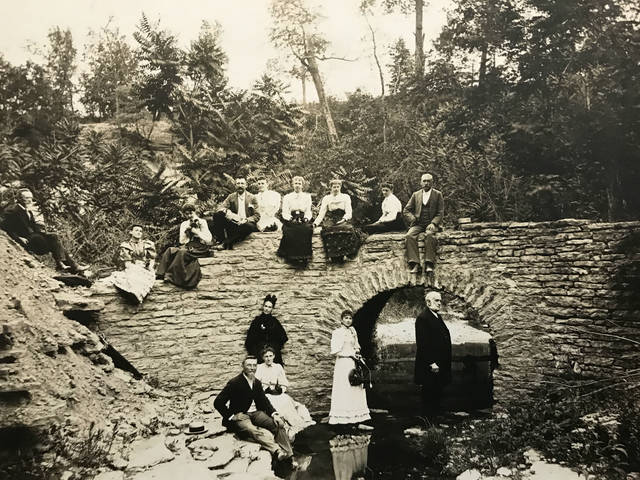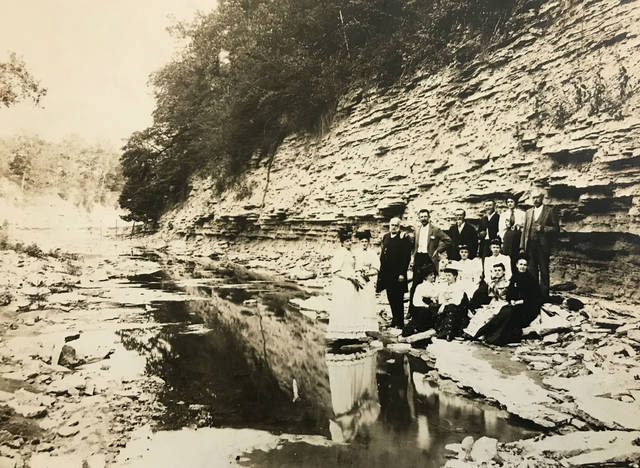

CAMDEN — Tucked just to the west of Camden, is one of our most beautiful and history-rich scenic areas…Devils Backbone. Paint Creek forged through the land centuries ago creating its steep gorges and winding path. Over the years, Devils backbone has been host to everything from big foot sightings and Sunday camp meetings to fossil studies, a skunk farm and a legendary curse.
Early settlers loved its beauty and would picnic and hold dances and concerts there. Early on, a stone bridge was built to allow access to town from the west. A modern iron bridge was constructed in 1877 and while it made some townsfolk happy, a few of their horses refused to cross it. So the old stone bridge continued to be used from time to time for horse and buggy crossings.
In 1967, modern vehicle transportation created the need for a new bridge. After road studies were completed, the bridge and road was relocated to its current location just south of the old bridge. The new bridge cost just $270,000 and would straighten out the curvy entrance to town from the west. Locals feared the beauty of the gorge would be lost so it was a high priority of the construction company to leave Devils Backbone in its natural state in addition making the road better for modern traffic. And they succeeded.
If you research Devils’ Backbone, you’ll find links to several big foot sightings and tracking groups. The mysterious creature has been spotted throughout the countryside, and naturally the wooded area surround Devils Backbone would seem a great spot for the large creature to thrive. So big foot stories flourished.
The geology department at Miami logged numerous fossil-studying trips over the years. In 1958, Backbone was reported as “one of the best areas anywhere for observing certain fossil specimens,” with some estimated to be 20,000 years old. A local missionary society documented the gathering of fossils back as early as 1874 and archive photos show members of Camden’s Presbyterian Church enjoying the day collecting fossils and posing for pictures on the jagged limestone ravine.
There was much activity of the hills of Devils backbone over the years. In 1915, a local Backbone farmer, Henry Avery, purchased some equipment to pulverize limestone for farm fertilizing purposes. Ahead of his time, Mr. Avery knew lime was a necessity for producing good standing crops like alfalfa and clover. In 1958, Frank White leased some of the land on the north side to start Preble Bow Hunters. The club hosted many events over the years bringing people in from all over the state to compete.
In 1908, a group of Camdenites even invested in a skunk farm. The group of men hoped to “get rich quick” likely by harvesting their pelts. They built a cement barrier around a natural habitat placed 72 skunks in the enclosure and left them to do their thing. The plan was to net 300 skunks by spring just by letting the skunks be skunks. Or be rabbits, we’re not sure.
When the investors returned in the spring to collect their rewards there were only seven skunks remaining. The enclosure was intact and there was nothing to explain the mysterious vanishing pole cats. Could this have been the work of Chief Little Turtle’s Curse?
What would a story about Devils Backbone be without the legend of Chief Little Turtle’s curse? According to history, Devils Backbone is the location of a sacred burial ground for Native American Royalty. When Native Americans were forced to move west, legend has it that Chief Little Turtle warned the white man that if the graves were disturbed “swift punishment” would follow. Each spring, locals reported seeing two mysterious dark-haired men roaming Backbone’s hillside but no one could ever get close enough to talk to the men.
Tragedy struck Devil’s Backbone in 1887. Herbert Howard was found murdered at his backbone farm. That murder remains unsolved to this day. Then there was the murder of Franklin Bourne on the same farm in 1912. Various accounts of how Franklin Bourne was killed have riddled the legends of Devils Backbone for years. Elwood Davis, Bourne’s farmhand, was convicted of the murder but he maintained his innocence until the day he died leaving some folks to believe that Bourne was a victim of the ghost scouts of the Miami Tribe and Chief Little Turtle’s curse.
Some folks believed there was a secret copper mine of the Miami tribe located on the hillside and many went searching for it. It has been recounted that Bourne had been digging around the farm in search of the copper mines and unearthed the bones of the burial ground. Even though his body wasn’t found until approximately 14 months after his disappearance, Bourne would have died about the same time of year the mysterious men appeared. Some speculate that Bourne’s untimely death was punishment for disturbing the sacred burial ground.
The story of Devil’s Backbone is not over, though. Early in 2016, the family of Patricia and Herb Wagers donated the 24 acres of Devil’s Backbone to the Preble County Park District. The Wagers family had owned the property since 1966 and allowed it to become a wildlife sanctuary with native plants and animals surrounding the scenic limestone formations and beautiful waterfalls. The Park District plans to develop a new park at Devil’s Backbone with hiking trails and picnic areas, while maintaining its natural state.
For more stories and photos detailing Camden’s first 200 years—its people, places, businesses and events—please visit us at our www.facebook.com/CamdenOHBicentennial2018 page.



